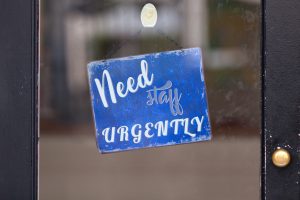The Year That Was 2022: Great Changes, Great Challenges
On the surface, 2022 appears to have been a successful year for the American worker. It began with the nation in the throes of yet another wave of COVID infections in this unprecedented pandemic. At the same time, our nation’s media focused their attention on the Great Resignation, where large numbers of employees voluntarily resigned from their jobs for a myriad of personal and professional reasons. By the end of the year, unemployment numbers returned to pre-pandemic levels of 3.8% according to the Bureau of Labor Statistics November jobs report. Yet within the prevailing narrative of millions of Americans voluntarily exiting the workforce, there was a very different story for Older Americans.
The Great Resignation
The COVID pandemic proved to be an awakening for millions of American workers, a great number of whom reevaluated their lives and priorities in the wake of the first waves of the pandemic. Indeed, for many, the desire to spend more time with their children and aging parents proved so compelling that it exceeded their willingness to remain in the workforce. Of the 47 million Americans who exited the workforce, younger Americans between the ages of 30 to 45 represented 50% of the total job leavers. However, for older workers who exited the workforce during this period, it was less a Great Resignation, and instead more a Great Shedding of those between the ages of 55 to 74. Older workers were essentially involuntarily removed from the workforce as employers sought to trim their payrolls.
According to a recent study from Theresa Ghilarducci at the New School’s Schwartz Center for Economic Policy Analysis, the retired  population between the ages of 55 to 74 increased beyond the normal trend by an additional 1.1 million people since March of 2020. Ghilarducci concluded that while that finding may play into the Great Resignation narrative, “most of these retirements occurred after periods of unemployment rather than directly from employment.”
population between the ages of 55 to 74 increased beyond the normal trend by an additional 1.1 million people since March of 2020. Ghilarducci concluded that while that finding may play into the Great Resignation narrative, “most of these retirements occurred after periods of unemployment rather than directly from employment.”
For 2023, absorbing older workers back into the workforce will require a fundamental re-evaluation of our workforce priorities and a willingness to embrace the many talents—and skills—embedded within this segment of the workforce, as well as a continuing acknowledgement in hiring practices that age is just a number.
A Historic Labor Shortage
2022 witnessed a national labor shortage of historic proportions. As our economy began its transition out of the pandemic, we were confronted by a phenomenon very few of us have experienced in our lifetime: a national shortage of workers. For most of the year, the Bureau of Labor Statistics reported approximately 10.6 million available jobs with only 6-7 million job seekers. The difference is attributable to the gap between the skills required for available positions and the capability of job seekers to perform these jobs. Yet for older workers, the U.S. labor shortage may provide a rare window of opportunity to return to a more welcoming work environment.
During a recent visit to a suburban community west of Cleveland, I observed something that I had rarely experienced in my adult life in the United States: a plethora of “help wanted” signs on the lawns, sidewalks, and buildings of industrial parks containing offices, warehouses, and factories. This is a clear indication that the historically depressed north-east Ohio region is experiencing a hiring shortage. Moreover, on closer examination of the signs, I noticed something more telling: employers were not only offering competitive wages and benefits, but also on-the-job training. The demand for labor has forced many employers to reassess not only their hiring strategies, but also important “add-ons” to attract the best and most willing candidates.
The demand for talent was omnipresent throughout 2022 and will likely continue into 2023 and 2024. However, with talent shortage comes worker and job seeker leverage. This will provide another rare window of opportunity for older workers to fill positions suited to their skills and experiences. The urgent need to hire talent will increasingly determine who gets interviewed and hired, rather than the irrelevant factor of the job seeker’s age, a known point of hiring bias.
Full Employment Recession
2022 is the year of confounding realities. On the one hand, the U.S. economy has gradually descended into an economic recession, yet on the other hand, we appear to have a full employment environment, where available jobs exceed the number of job seekers. In June of this year, the Federal Reserve Bank of Atlanta estimated that the U.S. economy had contracted by 1.2% in the second quarter, as seasonally adjusted. With these numbers closely mirroring economic performance data from the previous quarter, it was determined that the U.S. had met the technical definition of a recession.
The term “full employment recession” can be a little misleading. For behind the unemployment numbers are underlying trends that place the official numbers into context. According to an excellent Wall Street Journal Op-ed by James Piereson, “Today’s low unemployment rate obscures the substantial decline in workforce participation in recent years, as ‘dropouts’ from the workforce aren’t included in the unemployment figures. If they were added, as some analysts think they should be, then the real unemployment rate wouldn’t be 3.6% but more like 9% or 10%.” As noted above, one of the most significant groups that exited the U.S. workforce in 2021-2022 were our nation’s older workers. History has also informed us that older workers will experience the most significant barriers to re-entry.
Recessions of any length can be painful for those on limited means. It can be catastrophic to experience a prolonged recession.  The need to earn a decent wage in an environment of a 40- year high rate of inflation may prove the tipping point for older workers. For millions of older workers, the decision to return to their past careers will be a necessity, as the alternative may just be downward mobility and poverty. However, for older workers to succeed, a combination of federal workforce training programs like the Senior Community Service Employment Program (SCSEP) and employer on-the-job training programs will have to be deployed to support their transition back to work.
The need to earn a decent wage in an environment of a 40- year high rate of inflation may prove the tipping point for older workers. For millions of older workers, the decision to return to their past careers will be a necessity, as the alternative may just be downward mobility and poverty. However, for older workers to succeed, a combination of federal workforce training programs like the Senior Community Service Employment Program (SCSEP) and employer on-the-job training programs will have to be deployed to support their transition back to work.
Older Workers in a Hybrid Workforce
The tight labor market and the corresponding shift to a increasingly hybrid workforce has created a unique window of opportunity for older workers. A recent Forbes magazine article by Luciana Paulise noted that “[a] Gallup survey in June of 2022 found that 8 in 10 people are working hybrid or remote, while only 2 in 10 are entirely on-site. And an AT&T study found the hybrid work model is expected to grow from 42% in 2021 to 81% in 2024.” The inevitability of the gathering momentum towards a total transformation in our relationship to our jobs—and how and where we perform our tasks—will require a new set of technological and digital skills for employees to be successful. For low-income and older workers, this will require a renewed investment in workforce training.
One example of a unique approach being undertaken is the Center for Workforce Inclusion’s Digital Certification Program or “DCP.” This  program is targeted to low-income job seekers aged 55-and-over who have made the decision to return to work, but who lack the digital skills for today’s job market. The DCP is designed to meet the job seeker at their current skill level, to provide digital and technological training and, once completed, to assist the individual in securing a job. Job seekers who finish the DCP training will have the skills and tools to compete for employment opportunities that afford the opportunity to work from home.
program is targeted to low-income job seekers aged 55-and-over who have made the decision to return to work, but who lack the digital skills for today’s job market. The DCP is designed to meet the job seeker at their current skill level, to provide digital and technological training and, once completed, to assist the individual in securing a job. Job seekers who finish the DCP training will have the skills and tools to compete for employment opportunities that afford the opportunity to work from home.
In 2023 the U.S workforce development community must provide our nation’s job seekers with the tools to compete and succeed within our fast-evolving workforce. The timing for such development efforts could not be any better. The movement towards certifications and industry recognized credentials as evidence of skills preparedness—in conjunction with the de-emphasizing of college degrees as the gold standard for job readiness—is gradually transforming our nation’s hiring practices. It is therefore incumbent on the workforce community to ensure that our nation’s most vulnerable – and older job seekers – are in the front line of this transformation. There are millions of American job seekers who are relying on us to get this right.


